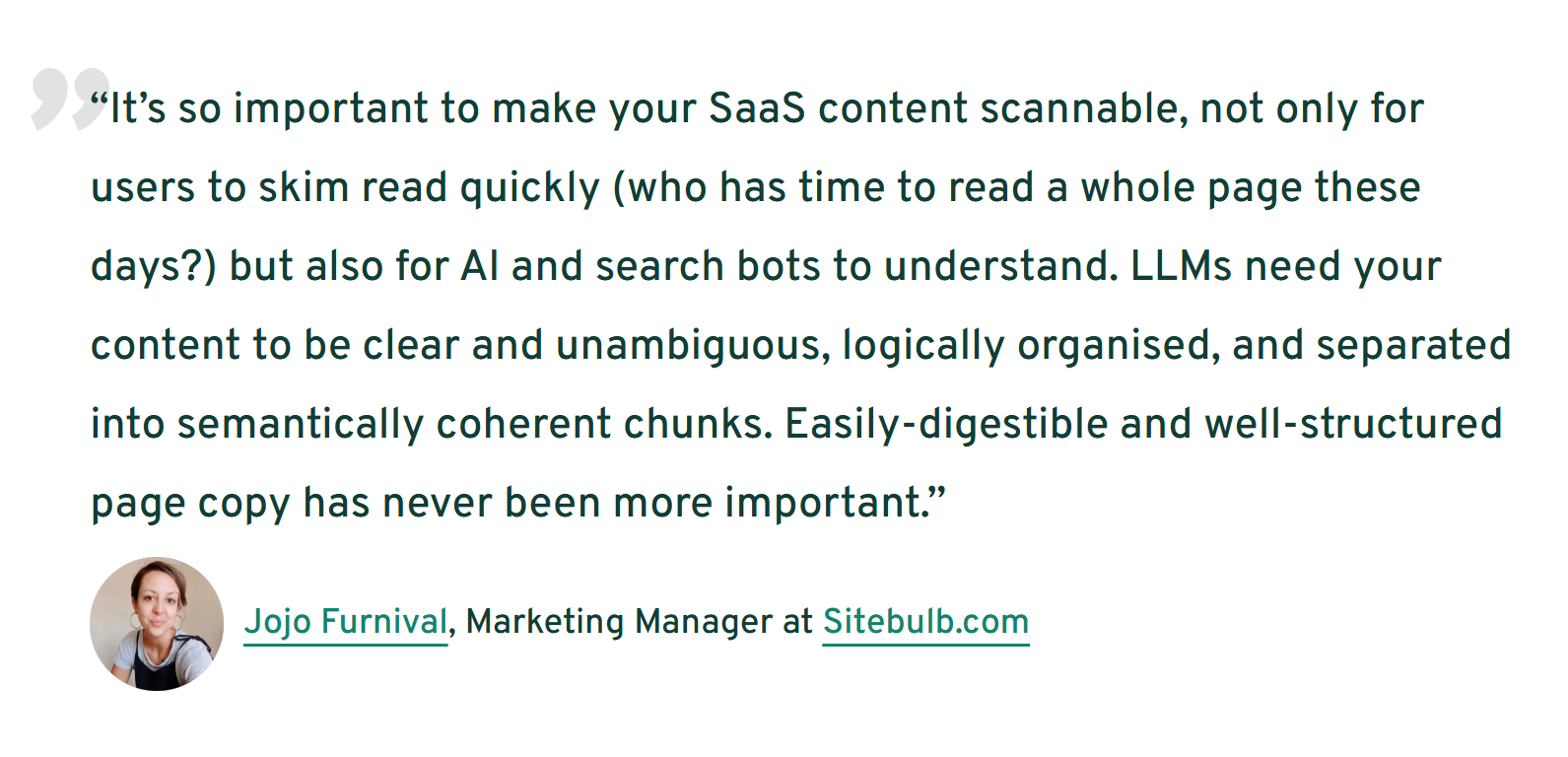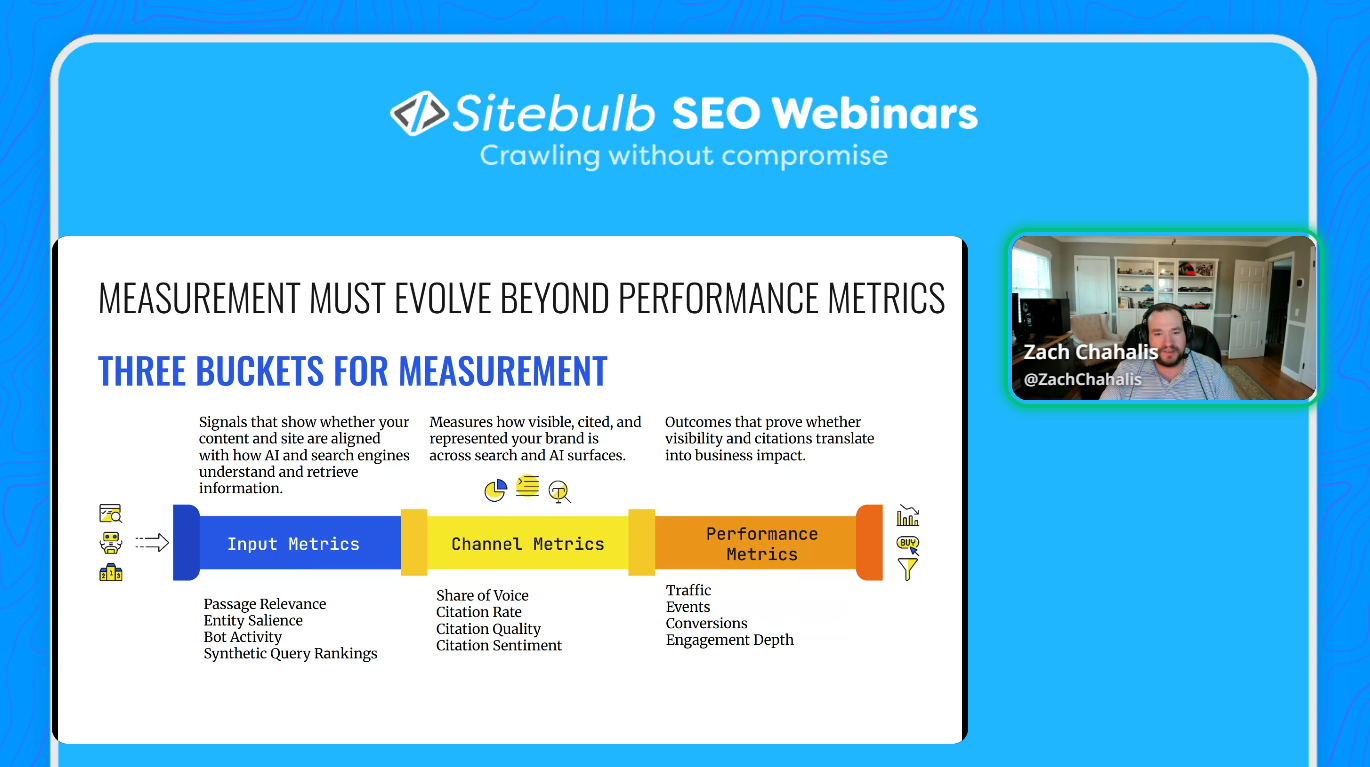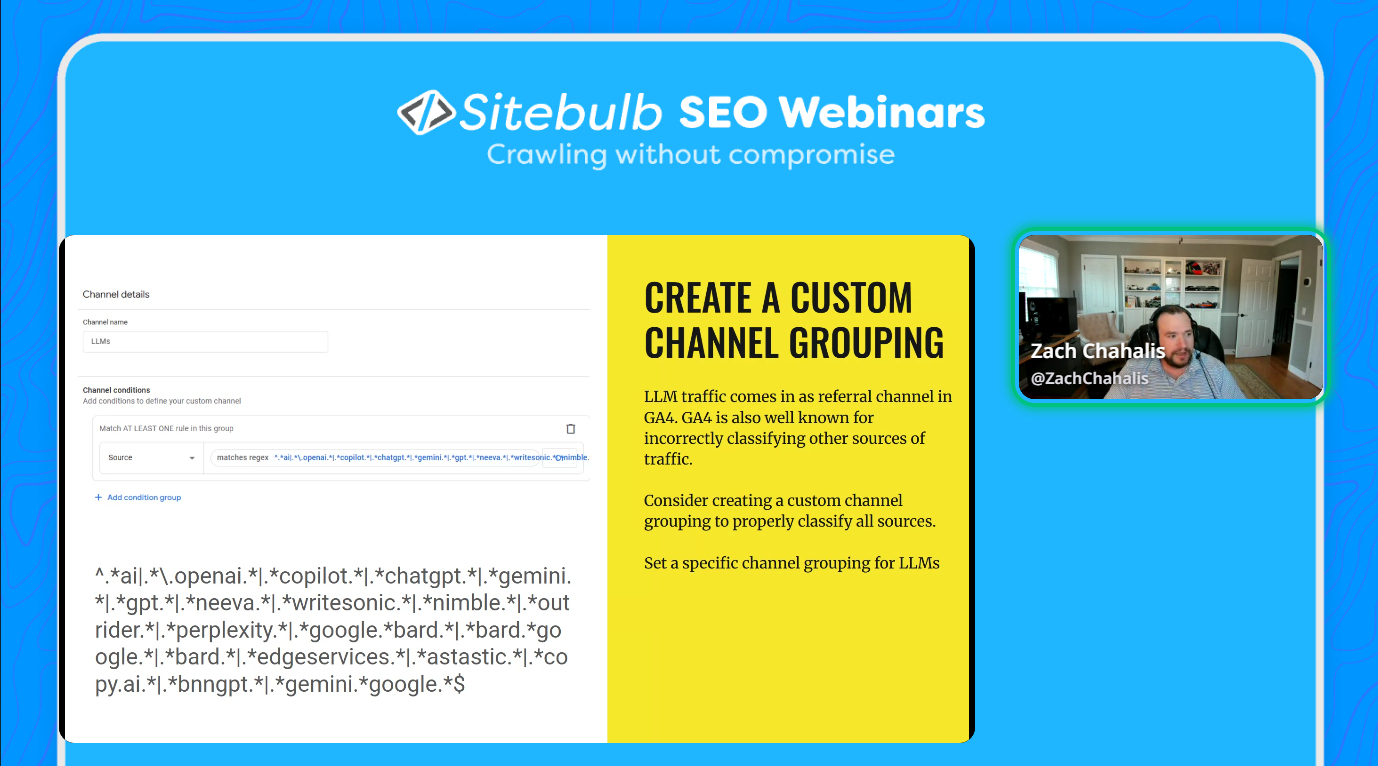
Speed-to-Meaning: Technical & Measurement Blueprint for AI Search
Published November 24, 2025
GEO vs SEO debate aside, we all know that the way people discover information has evolved beyond traditional web search. That much is stating the obvious.
But what’s not so immediately obvious is exactly how AI Overviews and conversational assistants are retrieving the information they cite in their responses.
Parts 1 and 2 of Sitebulb’s 3-part Search Matrix training series delivered by Zach Chahalis (both of which are available on-demand if you sign up now) provide a structured way to think about these AI-driven changes: part technical foundation, part measurement framework.
My aim with this article is to bring these two modules together and translate them into a practical, operational approach to AI search. I’m going to shed some light on how good old fashioned SEO principles now also influence this extra layer of AI-driven retrieval and citation.
I’m not proposing a dramatic pivot – unless your SEO strategy is built on lazy shortcuts and quick fixes – but an expansion of the outcomes SEOs should monitor. Rankings still matter, for sure, but so does the question of whether content is being seen, selected, and referenced by AI systems.
Contents:
The foundational technical pillars still apply
Part 1 of the training series breaks down five foundational pillars of technical SEO that still matter in the era of LLMs and answer engines:
Information architecture (IA)
Structured data
Crawlability
Rendering
Performance
Rather than replacing traditional SEO, AI Search optimisation or “GEO” (if you want to call it that) describes how those same elements influence this second layer of interpretation.
For example:
IA and internal linking help conversational systems understand relationships between pages
Structured data provides clearly defined entities that can support retrieval-augmented generation (RAG)
Performance and rendering determine how much of the page is available during embedding and parsing
Each of these technical SEO fundamentals is still relevant; the scope of its impact now extends further.
Speed-to-meaning: when content becomes extractable
Zach emphasises in Parts 1 & 2 the importance of how quickly meaningful content becomes available to LLM crawlers—not just how quickly a user sees a visually complete page.

“In terms of page speed and impact on LLM accessibility, focus should be on how fast the primary HTML and above-the-fold content arrive – two key metrics… TTFB and LCP. <3s to critical content is key.”
This recommendation isn’t presented as a rigid rule for all situations, but as a useful benchmark. Zach’s reasoning is straightforward:
Many AI crawlers operate with limited rendering budgets
If essential content is delayed or JS-dependent, it may not be captured
Module 1 echoes this when discussing rendering, and Zach’s advice is that key above-the-fold content is pre-rendered or server-side rendered.
Again, this isn’t a new requirement. In fact, it’s an established idea that server-rendered content is more reliable for indexing. It’s highlighted by Sam Torres and Tory Gray in Sitebulb’s JavaScript SEO Training Course. And now it’s also relevant for embedding and RAG pipelines.
In Part 1, we’re shown examples where the initial HTML response contains no meaningful content at all, with everything injected client-side.
Just be aware that if key content is missing from the response HTML and requires a full JS render to exist, some AI crawlers may not retrieve it. Sitebulb’s Response vs Render comparison is particularly useful here, as it highlights discrepancies that could affect both traditional indexing and AI-driven extraction.
PS. You might also wanna check out Sitebulb’s 2025 JavaScript SEO Report, which shows the level of confusion within the SEO community around which LLM crawlers have rendering capabilities and which don’t. The fact is, however, that even those that do, won’t necessarily expend precious resources on that process.
Internal linking and IA act as contextual pathways
In The Search Matrix training series, Zach explains the role of internal linking in a way that aligns with long-standing SEO guidance but also provides clarity for AI retrieval:

“Internal linking should not just pass authority — it should define relationships… AI crawlers follow internal links to infer conceptual adjacency.”
Zach highlights the way internal linking contributes to:
Topic clustering
Entity relationships
Page-to-page context
These are longstanding IA principles. What’s new is the explicit connection to how AI systems may traverse and interpret these relationships, especially when generating multi-source answers.
Structured data provides machine-readable clarity for RAG systems
We decided that this series was not the place or time to debate the controversial topic of structured data in today’s AI search landscape. However, what Zach does say is this:
“LLMs can and do use structured data as part of RAG pipelines.”
This doesn’t imply schema automatically improves visibility in AI systems, but it does reaffirm its role as a reliable, unambiguous signal of:
Entities
Attributes
Relationships
Clean @graph organisation gives AI systems a structured map of your concepts.
Consistent @id usage ensures entities are treated as the same thing across pages.
Up-to-date validation ensures models can actually parse and rely on your schema.
None of this replaces traditional SEO. But in an environment where AI systems increasingly reference, summarise or link to content, these practices help your site present a coherent, machine-readable version of itself.
Aim for clarity, accuracy, and consistency; ambiguity is the enemy of retrieval.
Passage structure, headings and well-defined chunks improve extractability

Image source: SEO Copywriting For SaaS, Flow Agency
Good content marketers have long known the importance of content organisation, so it’s no surprise that AI likes it too.
I myself have been banging this drum for at least a decade.
One main topic per section
Clear headings
Logical sub-headings
Scannable paragraphs
Direct answers to common sub-questions
These are long-standing editorial principles, but Zach clarifies in the training why they matter for AI systems that divide content into semantic units before ranking or selecting passages.
Measurement now includes citations, among other things

Part 2 of the training series, which features AI search visibility platform DemandSphere, introduces a measurement framework covering:
Input metrics: Passage relevance, entity salience, bot activity, synthetic query rankings
Channel metrics: Share of voice, citation rate, citation quality, citation sentiment
Performance metrics: Traffic, events, conversions, engagement depth
Again, don’t necessarily throw out your existing KPIs. But consider adding the above to round out the picture for monitoring how content appears in AI-driven interfaces.
Rankings remain relevant, of course. But understanding whether your content is being referenced in AI-generated responses adds useful context, especially for organisations where discovery increasingly takes place across several surfaces.
Top tip: Generic “referral” traffic as a source in GA4 is more or less pointless if you want to understand which LLMs are sending traffic to your website. You might want to create a custom channel grouping instead:

“GEO Readiness Checklist”: a practical workflow
At the end of Part 2, Zach wraps up with a checklist that effectively bridges both modules:
Below is how this translates into a Sitebulb-driven workflow (or I guess you could try and use another crawler if you want to BREAK MY HEART):
Crawlability
Review robots handling, canonicalisation, and sitemap completeness
Inspect crawl depth and internal link entry points
Rendering
Compare Response vs Render
Identify JS-modified or missing HTML
Schema
Check @graph consistency and entity relationships
IA & Linking
Map cluster structure and link hierarchies
Identify weak or orphaned sections
Performance
Monitor TTFB, LCP, and render-blocking behaviour
Evaluate how quickly meaningful content arrives
Closing thoughts
Just like the first and second films in the Matrix trilogy (IMHO), Parts 1 and 2 of this series are kick-ass. Zach delivers an epic amount of knowledge, tips, and insight into each 45-minute session.
One of the core messages that is reinforced throughout: the core of technical SEO remains relevant, but its influence now reaches further into how AI systems retrieve, interpret and synthesise information. No existing practices are rendered obsolete; rather, their impact is expanded across additional surfaces and models.
If you want to prepare for this broader landscape, focusing on reliable rendering, clear structure, stable performance, and strong information architecture is a practical way forward. Happily, Sitebulb already provides the diagnostics needed to evaluate these areas thoroughly—for both traditional search and AI-driven systems.

Jojo is Marketing Manager at Sitebulb. She has 15 years' experience in content and SEO, with 10 of those agency-side. Jojo works closely with the SEO community, collaborating on webinars, articles, and training content that helps to upskill SEOs.
When Jojo isn’t wrestling with content, you can find her trudging through fields with her King Charles Cavalier.
Articles for every stage in your SEO journey. Jump on board.
Related Articles
 Advanced SEO Guide to Rendering: How to Debug, Test & Control What Google Sees
Advanced SEO Guide to Rendering: How to Debug, Test & Control What Google Sees
 JavaScript SEO Fundamentals: Guide to Web Rendering Techniques
JavaScript SEO Fundamentals: Guide to Web Rendering Techniques
 How to Stay Relevant in a World of AI Overviews & Query-Fans
How to Stay Relevant in a World of AI Overviews & Query-Fans
 Sitebulb Desktop
Sitebulb Desktop
Find, fix and communicate technical issues with easy visuals, in-depth insights, & prioritized recommendations across 300+ SEO issues.
- Ideal for SEO professionals, consultants & marketing agencies.
Try our fully featured 14 day trial. No credit card required.
Try Sitebulb for free Sitebulb Cloud
Sitebulb Cloud
Get all the capability of Sitebulb Desktop, accessible via your web browser. Crawl at scale without project, crawl credit, or machine limits.
- Perfect for collaboration, remote teams & extreme scale.
If you’re using another cloud crawler, you will definitely save money with Sitebulb.
Explore Sitebulb Cloud Jojo Furnival
Jojo Furnival




